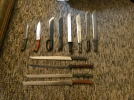- Joined
- Nov 20, 2005
- Messages
- 19,385
I can't say I disagree with you. For me, unless I'm at home, I will have ONE machete with me in my truck. It will get used for both chopping and wacking flimsy stuff. I really like the 18" El Salvador model, but if I am going to carry it walking, I will usually go with the shorter 14" Puerto Rican (same as 16" Swamp Master, just 14" vs 16"). It is rigid enough for chopping small trees and light enough for flimsy stuff for modest wacking efforts.You need to get a professionally done convex grind on that blade. The convex, plus experience wielding it, this blade has completely replaced (for me) the need to use or even own small hatchets and axes. I still have a full-sized axes, but around home for light limb and tree chopping duties, and definitely when car camping or backpacking when a full-sized axe would be a non-option, I can always do great with either my Golok, or when possible, I go even a bit smaller to a "large knife" such as my ESEE Junglas I, the one with the 10" blade. Everybody has their prefs on this stuff, but I find that the Golok properly sharpened and used, or the ESEE for lighter tasks, just replaces a whole bevy of heavier and specialized tools that I find I no longer need. Now for large heavy-duty chopping chores around home, I still go to my full-size axe. And for significant weed whacking work, I still go to a traditional lighter thinner-bladed machete (my Tramontina), because it doesn't tired you out as fast and is more optimized to that kind of work if you're doing a lot of it. But if I'm just doing general all-purpose weed whacking, limbing, brush-clearing, and light to medium wood chopping (we get a lot of that here in the Pacific NW, your property turns into a jungle darn quick on the west side of the Cascades), nothing is a better do-it-all tool than the Golok. In my humble opinion.
I want to get the Swamp Master, but the price made me shy away from it the other day as I certainly don't need it.
Last edited:



